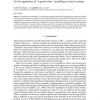Free Online Productivity Tools
i2Speak
i2Symbol
i2OCR
iTex2Img
iWeb2Print
iWeb2Shot
i2Type
iPdf2Split
iPdf2Merge
i2Bopomofo
i2Arabic
i2Style
i2Image
i2PDF
iLatex2Rtf
Sci2ools
JCNS
2006
2006
On the application of "equation-free modelling" to neural systems
"Equation-free modelling" is a recently-developed technique for bridging the gap between detailed, microscopic descriptions of systems and macroscopic descriptions of their collective behaviour. It uses short, repeated bursts of simulation of the microscopic dynamics to analyse the effective macroscopic equations, even though such equations are not directly available for evaluation. This paper demonstrates these techniques on a variety of networks of model neurons, and discusses the advantages and limitations of such an approach. New results include an understanding of the effects of including gap junctions in a model capable of sustaining spatially localised "bumps" of activity, and an investigation of a network of coupled bursting neurons.
| Added | 13 Dec 2010 |
| Updated | 13 Dec 2010 |
| Type | Journal |
| Year | 2006 |
| Where | JCNS |
| Authors | Carlo R. Laing |
Comments (0)

